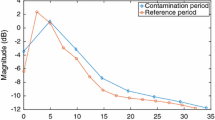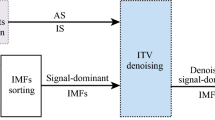Abstract
A method based on independent component analysis (ICA) and empirical mode decomposition (EMD) for processing electromyographic (EMG) signals is proposed. This method is used for determining the motor activation pattern of the lower extremities during walking. The method is evaluated by recording EMG signals from 11 healthy women. The EMG signals used for the analysis are recorded from 16 muscles of both lower limbs during walking. The method consists of preprocessing the EMG signals using principal component analysis, analyzing them using ICA, and finally filtering them using EMD. This approach allows the reconstruction of the original source signals by filtering the components that do not have a muscular origin. These data are then segmented and processed using the Hilbert transform in order to obtain a representation of a gait cycle from all records. The activation patterns obtained with this method are compared to the ones obtained using a conventional method, based on low-pass filtering, and a method based only on EMD filtering. According to the results, the proposed method obtains a better sequence of motor activation during walking. The proposed method is validated by a comparison of the results with kinematic behavior (expressed as the angular movement of the hip, knee, and ankle of each participant) and statistical significance analysis.










Similar content being viewed by others
References
Huang, S., & Ferris, D. (2012). Muscle activation patterns during walking from transtibial amputees recorded within the residual limb-prosthetic interface. Journal of NeuroEngineering and Rehabilitation, 9(55), 1–16.
Lauer, R. T., Stackhouse, C., Shewokis, P. A., Smith, B. T., Orlin, M., & McCarthy, J. J. (2005). Assessment of wavelet analysis of gait in children with typical development and cerebral palsy. Journal of Biomechanics, 38(6), 1351–1357.
Manganelli, F., Pisciotta, C., Dubbioso, R., Iodice, R., Criscuolo, C., Ruggiero, L., et al. (2011). Electrophysiological characterisation in hereditary spastic paraplegia type 5. Clinical Neurophysiology, 122(4), 819–822.
Tropea, P., Monaco, V., Coscia, M., Posteraro, F., & Micera, S. (2013). Effects of early and intensive neuro-rehabilitative treatment on muscle synergies in acute post-stroke patients: A pilot study. Journal of NeuroEngineering and Rehabilitation, 10(1), 1–15.
Santilli, V., Frascarelli, M. A., Paoloni, M., Frascarelli, F., Camerota, F., DeNatale, L., et al. (2005). Peroneus longus muscle activation pattern during gait cycle in athletes affected by functional ankle instability: A surface electromyographic study. The American Journal of Sports Medicine, 33(8), 1183–1187.
Perry, J. (2010). Gait analysis: Normal and pathological function (2nd ed.). Thorofare, NJ: Slack Incorporated.
Pedotti, A. (1977). A study of motor coordination and neuromuscular activities in human locomotion. Biological Cybernetics, 26(1), 53–62.
Frigo, C., & Shiavi, R. (2004). Applications in movement and gait analysis. In R. Merletti & P. J. Parker (Eds.), Electromyography: Physiology, engineering, and noninvasive applications (pp. 381–401). New York: Wiley-IEEE Press.
Winter, D., & Yack, H. (1987). EMG profiles during normal human walking: Stride-to-stride and inter-subject variability. Electroencephalography and Clinical Neurophysiology, 67(5), 402–411.
Winter, D. A. (2009). Biomechanics and motor control of human movement (4th ed., pp. 45–81). New York: Wiley.
Chang, S. S., De Luca, C., Nawab, S. (2008). Aliasing rejection in precision decomposition of EMG signals. In IEEE 30th annual international conference of the engineering in medicine and biology society (EMBS 2008) (pp. 4972–4975).
Winter, D., Fuglevand, A., & Archer, S. (1994). Crosstalk in surface electromyography: Theoretical and practical estimates. Journal of Electromyography and Kinesiology, 4(1), 15–26.
Frigo, C., & Crenna, P. (2009). Multichannel SEMG in clinical gait analysis: A review and state-of-the-art. Clinical Biomechanics, 24(3), 236–245.
Lin, S. L., Tung, P. C., & Huang, N. E. (2009). Data analysis using a combination of independent component analysis and empirical mode decomposition. Physical Review E, 79(6), 066705.
Mijović, B., DeVos, M., Gligorijević, I., Taelman, J., & VanHuffel, S. (2010). Source separation from single-channel recordings by combining empirical-mode decomposition and independent component analysis. IEEE Transactions on Biomedical Engineering, 57(9), 2188–2196.
Guo, Y., Huang, S., & Li, Y. (2012). Single-mixture source separation using dimensionality reduction of ensemble empirical mode decomposition and independent component analysis. Circuits, Systems, and Signal Processing, 31(6), 2047–2060.
Hermens, H. J., Freriks, B., Disselhorst Klug, C., & Rau, G. (2000). Development of recommendations for semg sensors and sensor placement procedures. Journal of Electromyography and Kinesiology, 10(5), 361–374.
Kreyszig, E. (2007). Advanced engineering mathematics. New York: Wiley.
Hyvärinen, A., & Oja, E. (2000). Independent component analysis: Algorithms and applications. Neural Networks, 13(4), 411–430.
Jolliffe, I. (2002). Principal component analysis. New York: Wiley.
Ren, X., Yan, Z., Wang, Z., & Hu, X. (2006). Noise reduction based on ICA decomposition and wavelet transform for the extraction of motor unit action potentials. Journal of Neuroscience Methods, 158(2), 313–322.
Delorme, A., Sejnowski, T., & Makeig, S. (2007). Enhanced detection of artifacts in EEG data using higher- order statistics and independent component analysis. NeuroImage, 34(4), 1443–1449.
Alvarez, D. A., Giraldo, E. (2008). ICA aplicado a la extracción de características en imágenes. Scientia Et Technica, XIV, 43–48.
Bishop, D., & Hardiman, M. (2010). Measurement of mismatch negativity in individuals: A study using single- trial analysis. Psychophysiology, 47(4), 697–705.
Kelly, R. E., Alexopoulos, G. S., Wang, Z., Gunning, F. M., Murphy, C. F., Morimoto, S. S., et al. (2010). Visual inspection of independent components: Defining a procedure for artifact removal from fMRI data. Journal of Neuroscience Methods, 189(2), 233–245.
Perlbarg, V., Bellec, P., Anton, J. L., Pélégrini-Issac, M., Doyon, J., & Benali, H. (2007). Corsica: Correction of structured noise in fMRI by automatic identification of ICA components. Magnetic Resonance Imaging, 25(1), 35–46.
Huang, N. E., Shen, Z., Long, S. R., Wu, M. C., Shih, H. H., Zheng, Q., et al. (1998). The empirical mode decomposition and the hilbert spectrum for nonlinear and non-stationary time series analysis. Proceedings of the Royal Society of London. Series A: Mathematical, Physical and Engineering Sciences, 454(1971), 903–995.
Andrade, A. O., Nasuto, S., Kyberd, P., Sweeney-Reed, C. M., & Van Kanijn, F. (2006). EMG signal filtering based on empirical mode decomposition. Biomedical Signal Processing and Control, 1(1), 44–55.
Acknowledgements
The authors would like to thank the personnel and professionals working at the Movement Analysis Laboratory of the Pontificia Universidad Católica de Chile, Santiago, Chile, where the tests and experiments were done.
Author information
Authors and Affiliations
Corresponding author
Rights and permissions
About this article
Cite this article
Tapia, C., Daud, O. & Ruiz-del-Solar, J. EMG Signal Filtering Based on Independent Component Analysis and Empirical Mode Decomposition for Estimation of Motor Activation Patterns. J. Med. Biol. Eng. 37, 140–155 (2017). https://doi.org/10.1007/s40846-016-0201-5
Received:
Accepted:
Published:
Issue Date:
DOI: https://doi.org/10.1007/s40846-016-0201-5




